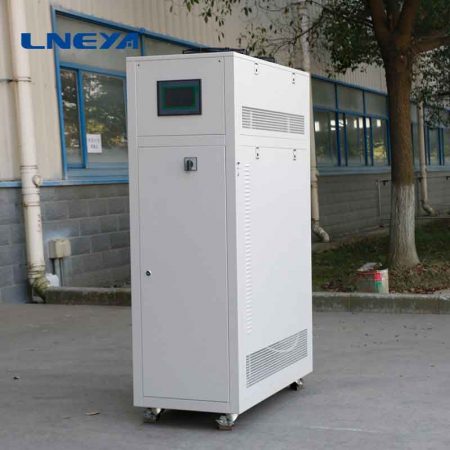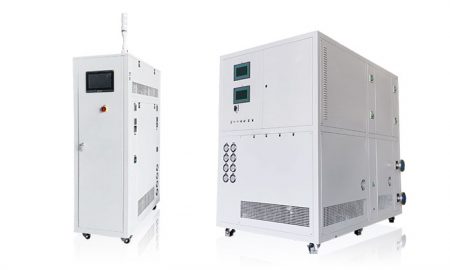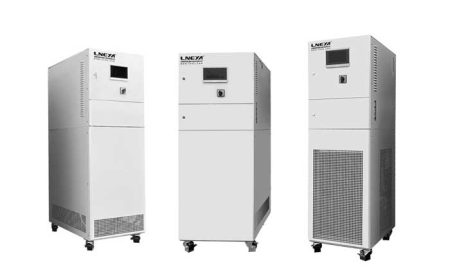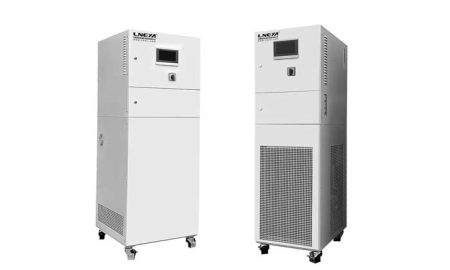Cold Water Recirculating System
Overview of cold water recirculating system
The cold water recirculating system is configured for water cooling of production equipment. A cooling water system that uses water as the cooling medium and circulates it. After the cold water flows through the production equipment that needs to be cooled (often called heat exchange equipment, such as heat exchangers, condensers, and reactors), the temperature rises. If it is discharged immediately, the cold water is only used once (called a DC cooling water system). When the heated cold water flows through the cooling equipment, the water temperature will drop back, and the consumption of cold water will be greatly reduced, often saving more than 95%. Cooling water accounts for about 70% of industrial water consumption, so cold water recirculating system plays a role in saving a lot of industrial water.

Cold water recirculating system generally consists of the following parts:
1. Heat exchangers in the production process
2. Cooling the structure
3 circulating water pump and sump.
Cooling structures for cooling water cooling treatment generally use cooling pools or cooling towers. Its working process is as follows: the circulating water is transported by the water pump to the water supply main pipe, and then enters each production equipment that needs cooling treatment, flows through the parts that need to be cooled, and then collects into the return water main pipe, and sprays downwards through the water distribution pipe above the cooling water tower . When the fan on the top of the cooling water tower is running, the return water flows back into the water storage tank after sufficient heat exchange with the air flow in the packing layer.
Classification of cold water recirculating system
Cooling equipment can be divided into open type and closed type, so cold water recirculating system is also divided into open type and closed type. Open systems are more complex to design and operate.
Open type: There are two types of cooling equipment, cooling pools and cooling towers, both of which mainly rely on the evaporation of water to reduce the water temperature. Fans are often used in cooling towers to promote evaporation, and cooling water is often blown away. Therefore, the open cold water recirculating system must supply fresh water. Due to evaporation, the circulating water is concentrated, and the concentration process will promote salt scaling. Make-up water has a dilution effect, and its flow rate is often determined according to the concentration limit of circulating water. Usually the amount of added water exceeds the amount of water lost by evaporation and wind, so some circulating water (called sewage) must be discharged to maintain the balance of water.
In an open system, due to the contact between the water flow and the atmosphere, dust, microorganisms, etc. enter the circulating water; in addition, the escape of carbon dioxide and the leakage of materials in the heat exchange equipment also change the water quality of the circulating water. For this reason, circulating cooling water often requires treatment, including sediment control, corrosion control and microbial control. The determination of the treatment method is often related to the water quantity and quality of the make-up water, as well as the performance of the production equipment. When multiple agents are used, possible chemical reactions between agents should be avoided.
Closed The closed cold water recirculating system adopts closed cooling equipment, the circulating water flows in the tube, and the outside of the tube usually uses wind to dissipate heat. Except for the material leakage of the heat exchange equipment, there are no other factors that change the water quality of the circulating water. In order to prevent the formation of salt scale in the heat exchange equipment, sometimes the cooling water needs to be softened. In order to prevent heat exchange equipment from being corroded, corrosion inhibitors are often added; when using high-concentration and highly toxic corrosion inhibitors, pay attention to safety, and the cooling water discharged during maintenance should be properly disposed of.
Correo electrónico: info@lneya.com WeChat ID: +8615251628237 WhatsApp: +86 17851209193
 Enfriadoras de precisión / Enfriadoras pequeñas (Diseños a medida)
Enfriadoras de precisión / Enfriadoras pequeñas (Diseños a medida)
El enfriador puede utilizarse ampliamente en diversas industrias y laboratorios, y admite diseños personalizados.
| Temperatura | -18°C ~ +30°C | Serie +5°C ~ +35°C |
| Capacidad de refrigeración | 0,35 ~ 0,9 kW | 1,8 ~ 50 kW |

Enfriadoras de recirculación (Diseños a medida)
Nuestro enfriador de recirculación adopta tecnología de refrigeración de baja temperatura, la temperatura es tan baja como -120℃, y varios accesorios son personalizables.
| Temperatura | Serie -25°C ~ +30°C | Serie -45°C ~ +30°C | Serie -60°C ~ -20°C | Serie -80°C ~ -20°C | Serie -120°C ~ -70°C |
| Capacidad de refrigeración | 0,8 ~ 30 kW | 0,75 ~ 12 kW | 0,4 ~ 6kW | 0,2 ~ 6kW | 0,3 ~ 5kW |

Refrigeradores de baja temperatura (Diseños a medida)
Estamos especializados en la producción de refrigeradores de baja temperatura con un rango de control de temperatura de hasta -150°C, que pueden satisfacer las necesidades de refrigeración de diferentes industrias.
| Temperatura | Serie -25°C ~ -5°C | Serie -45°C ~ -10°C | Serie -60°C ~ -10°C | Serie -80°C ~ -30°C | Serie -110°C ~ -50°C | Serie -150°C ~ -110°C |
| Capacidad de refrigeración | 12 ~ 360 kW | 6 ~ 180 kW | 6 ~ 180 kW | 4 ~ 180kW | 2 ~ 120kW | 2,5 ~ 11 kW |
 Chillers for Automotive Battery Test
Chillers for Automotive Battery Test
Simulación de temperatura para pruebas de calidad de vehículos: prueba de duración de baterías, banco de pruebas de inyectores/motores de combustible, prueba de airbags, banco de pruebas de componentes, etc.
| Temperatura | -25°C ~ +100°C | -40°C ~ +100°C | 0°C ~ +100°C | -40°C ~ +135°C |
| Capacidad de refrigeración | 2,8 ~ 38 kW | 1,2 ~ 60 kW | 1,8 ~ 60 kW | 4 ~ 60kW |
La temperatura, la presión y el caudal pueden controlarse de forma independiente.
1&2: una máquina para el control de dos grupos.
| Temperatura | -40 ~ +100℃ 1&2 | 0 ~ +100℃ 1&2 |
| Capacidad de refrigeración | 1,8 kW*2 ~ 60 kW*2 | 1,8 kW*2 ~ 60 kW*2 |
La temperatura permanece constante, la presión y el caudal pueden controlarse independientemente.
1&3: una máquina para el control de tres grupos.
1&6: una máquina para el control de seis grupos.
| Temperatura | -40 ~ +100℃ 1&2 | -40 ~ +100℃ 1&3 | -40 ~ +100℃ 1&6 | -20 ~ +100℃ 1&6 | 0 ~ +100℃ 1&2 | 0 ~ +100℃ 1&3 | 0 ~ +100℃ 1&6 |
| Capacidad de refrigeración | 2,5 ~ 60 kW | 4 ~ 60kW | 10 ~ 60 kW | 10 ~ 60 kW | 7 ~ 60 kW | 11 ~ 60kW | 18 ~ 60 kW |

Enfriadoras para semiconductores (TES series)
Adecuado para el control preciso de la temperatura de los componentes electrónicos. En la fabricación de componentes electrónicos semiconductores para entornos adversos, las fases de ensamblaje de embalajes de CI y de pruebas de ingeniería y producción incluyen pruebas térmicas electrónicas y otras simulaciones de pruebas ambientales.
| Temperatura | Serie -45°C ~ +250°C | Serie -85°C ~ +200°C | Serie -60°C ~ +200°C |
| Capacidad de refrigeración | 0,3 ~ 25 kW | 0,25 ~ 25 kW | 3 ~ 60kW |

Enfriadoras para semiconductores (LTS series)
Adecuado para el control preciso de la temperatura de los componentes electrónicos. En la fabricación de componentes electrónicos semiconductores para entornos adversos, las fases de ensamblaje de embalajes de CI y de pruebas de ingeniería y producción incluyen pruebas térmicas electrónicas y otras simulaciones de pruebas ambientales.
| Temperatura | Serie -20°C ~ +80°C | Serie -45°C ~ +80°C | Serie -60°C ~ +80°C | Serie -80°C ~ +80°C |
| Control de caudal | 7 ~ 45 L/min | 7 ~ 45 L/min | 7 ~ 45 L/min | 7 ~ 45 L/min |

Enfriadoras para semiconductores (FLT series)
El enfriador del sistema de control de temperatura de semiconductores se utiliza principalmente para el control preciso de la temperatura en el proceso de producción de semiconductores y el proceso de pruebas. Está especialmente desarrollado y diseñado para la industria de semiconductores.
| Temperatura | +5°C ~ +40°C | -25°C ~ +40°C | -45°C ~ +40°C | -80°C ~ +80°C | -100°C ~ +80°C |
| Capacidad de refrigeración | 6 ~ 40kW | 2 ~ 15kW | 1 ~ 8kW | 0,6 ~ 3 kW | 1,5 ~ 3 kW |

Enfriadoras para semiconductores (FLTZ Series Frequency Conversion)
El sistema de control de temperatura de la serie de conversión de doble frecuencia, la bomba de circulación y el compresor se ajustan mediante conversión de frecuencia.
| Temperatura | -30°C ~ +40°C |
| Capacidad de refrigeración | 5 ~ 11kW |

Enfriadoras para semiconductores (ETCU series)
Tipo de intercambio térmico
Sistema sin compresor
| Temperatura | +5°C ~ +90°C |
| Capacidad de refrigeración | 5 ~ 30 kW |

Enfriadoras para semiconductores (ZLFQ series)
Unidad de distribución de refrigerante
El equipo de refrigeración líquida es adecuado para pruebas de semiconductores, pruebas de temperatura constante de equipos electrónicos, infraestructura de soporte de servidores de refrigeración y otros lugares de control de temperatura de fluidos.
| Temperatura | +5°C ~ +35°C |
| Capacidad de refrigeración | 15 ~ 500 kW |

Enfriadoras para almacenamiento de energía(Diseños a medida)
Liquid Cooling Solutions For Battery Energy Storage Systems
| Temperatura | -45°C ~ +55°C |
| Capacidad de refrigeración | 45 kW |
 LNEYA
LNEYA
 简体中文
简体中文


















































































